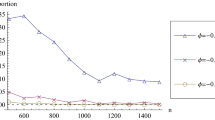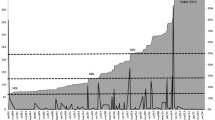Abstract
Kulp et al. proposed the number of missing ordinal patterns as a test statistic to detect the nonlinearity of time series in 2017. Inspired by the article, we propose a novel method called the number of missing dispersion patterns (NMDPs), which refers to the number of dispersion patterns that do not appear in the series after being symbolized using the Rostaghi and Azami method. The proposed method can distinguish between deterministic and stochastic dynamics well. By comparing the statistical difference between the NMDP results of the original series and the NMDP results of the wavelet iterative amplitude adjustment Fourier transform surrogate series, NMDP is demonstrated as a useful statistic for testing series nonlinearity. In this paper, we first apply NMDP to the model time series and verify its effectiveness as a test for determinism as well as nonlinearity and its ability to distinguish noise-contaminated series from purely stochastic series. We then apply NMDP to different stock index time series. The experiment results show that our method may be a suitable tool for quantifying the complexity of the inherent structure of the market under different development levels.

















Similar content being viewed by others
Data availability
The datasets generated and analyzed during the current study are available from the corresponding author on reasonable request.
References
Lewis, P.A.W., Stevens, J.G.: Nonlinear modeling of time series using multivariate adaptive regression splines (MARS). J. Am. Stat. Assoc. 86(416), 864–877 (1991)
Abarbanel, H.D.I., Brown, R., Sidorowich, J.J., Tsimring, L.S.: The analysis of observed chaotic data in physical systems. Rev. Mod. Phys. 65(4), 1331 (1993)
Costa, M.D., Goldberger, A.L., Peng, C.: Multiscale entropy analysis of complex physiologic time series. Phys. Rev. Lett. 89(6), 068102 (2002)
Grassberger, P., Procaccia, I.: Measuring the strangeness of strange attractors. Physica D 9(1–2), 189–208 (1983)
Kaplan, D.T., Glass, L.: Direct test for determinism in a time series. Phys. Rev. Lett. 68(4), 427–430 (1992)
Poon, C., Barahona, M.: Titration of chaos with added noise. Proc. Natl. Acad. Sci. USA 98(13), 7107–7112 (2001)
Small, M., Yu, D., Harrison, R.G.: Surrogate test for pseudo periodic time series data. Phys. Rev. Lett. 87(18), 188101 (2001)
Small, M., Tse, C.K.: Applying the method of surrogate data to cyclic time series. Physica D 164(3), 187–201 (2002)
Yang, Z., Zhao, G.: Application of symbolic techniques in detecting determinism in time series. In: IEEE Engineering in Medicine and Biology Magazine (1998)
Kulp, C.W., Smith, S.: Characterization of noisy symbolic time series. Phys. Rev. E 83(2), 026201 (2011)
Theiler, J., Eubank, S., Longtin, A., Galdrikian, B., Farmer, J.D.: Testing for nonlinearity in time series: the method of surrogate data. Physica D 58(1–4), 77–94 (1992)
Bandt, C., Pompe, B.: Permutation entropy: a natural complexity measure for time series. Phys. Rev. Lett. 88(17), 174102 (2002)
Kulp, C.W., Zunino, L., Osborne, T., Zawadzki, B.: Using missing ordinal patterns to detect nonlinearity in time series data. Phys. Rev. E 96(2), 022218 (2017)
José, M., Amigó, K.M.B., Kocarev, L.: The permutation entropy rate equals the metric entropy rate for ergodic information sources and ergodic dynamical systems. Physica D 210(1–2), 77–95 (2005)
Amigó, J.M., Kocarev, L., Szczepanski, J.: Order patterns and chaos. Phys. Lett. A 355(1), 27–31 (2006)
Amigó, J.M., Zambrano, S., Sanjuán, M.A.F.: True and false forbidden patterns in deterministic and random dynamics. EPL 79(5), 50001 (2007)
Amigó, J.M., Zambrano, S., Sanjuán, M.A.F.: Combinatorial detection of determinism in noisy time series. EPL 83(6), 60005 (2008)
Amigó, J.M., Zambrano, S., Sanjuán, M.A.F.: Detecting determinism in time series with ordinal patterns: a comparative study. Int. J. Bifurcat. Chaos 20(09), 2915–2924 (2010)
Schreiber, T., Schmitz, A.: Improved surrogate data for nonlinearity tests. Phys. Rev. Lett. 77(4), 635 (1996)
Schreiber, T., Schmitz, A.: Surrogate time series. Physica D 142(3–4), 346–382 (2000)
Venema, V., Ament, F., Simmer, C.: A stochastic iterative amplitude adjusted Fourier transform algorithm with improved accuracy. Tellus A (2006)
Rostaghi, M., Azami, H.: Dispersion entropy: a measure for time-series analysis. IEEE Signal Process. Lett. 23(5), 610–614 (2016)
Azami, H., Kinney-Lang, E., Ebied, A., Fernández, A., Escudero, J.: Multiscale dispersion entropy for the regional analysis of resting-state magnetoencephalogram complexity in Alzheimer’s disease. In: IEEE Engineering in Medicine and Biology Magazine (2017)
Azami, H., Fernández, A., Escudero, J.: Multivariate multiscale dispersion entropy of biomedical times series. Entropy 21(9), 913 (2019)
Li, C., Zheng, J., Pan, H., Tong, J., Zhang, Y.: Refined composite multivariate multiscale dispersion entropy and its application to fault diagnosis of rolling bearing. IEEE Access 7, 47663–47673 (2019)
Carpi, L.C., Saco, P.M., Rosso, O.A.: Missing ordinal patterns in correlated noises. Physica A 389(10), 2020–2029 (2010)
Mccullough, M., Sakellariou, K., Stemler, T., Small, M.: Counting forbidden patterns in irregularly sampled time series. I. The effects of under-sampling, random depletion, and timing jitter. Chaos 26(12), 123103 (2016)
Keylock, C.J.: Constrained surrogate time series with preservation of the mean and variance structure. Phys. Rev. E 73(3), 036707 (2006)
Lucio, J.H., Valdés, R., Rodríguez, L.R.: Improvements to surrogate data methods for nonstationary time series. Phys. Rev. E 85(5), 056202 (2012)
Rios, R.A., Small, M., De Mello, R.F.: Testing for linear and nonlinear Gaussian processes in nonstationary time series. Int. J. Bifurcat. Chaos 25(1), 1550013 (2015)
Lancaster, G., Iatsenko, D., Pidde, A., Ticcinelli, V., Stefanovska, A.: Surrogate data for hypothesis testing of physical systems. Phys. Rep. 748, 1–60 (2018)
Casali, K.R., Casali, A.G., Montano, N., Irigoyen, M.C., Macagnan, F., Guzzetti, S., Porta, A.: Multiple testing strategy for the detection of temporal irreversibility in stationary time series. Phys. Rev. E: Stat. Nonlinear Soft Matter Phys. 77(6), 601–611 (2008)
Freitas, U.S., Letellier, C., Aguirre, L.A.: Failure in distinguishing colored noise from chaos using the “noise titration’’ technique. Phys. Rev. E 79(3), 035201 (2009)
Benedicks, M., Carleson, L.: The dynamics of the Hénon map. Ann. Math. 133(1), 73–169 (1991)
Lamb, J.S.W., Roberts, J.A.G.: Time-reversal symmetry in dynamical systems: a survey. Physica D 112(1–2), 1–39 (1998)
Funding
This work was supported by the financial support from the Fundamental Research Funds for the Central Universities (2020YJS185) and the National Natural Science Foundation of China (61771035).
Author information
Authors and Affiliations
Corresponding author
Ethics declarations
Conflict of interests
The authors declare that they have no conflict of interest concerning the publication of this manuscript.
Additional information
Publisher's Note
Springer Nature remains neutral with regard to jurisdictional claims in published maps and institutional affiliations.
Appendices
Appendix A: The effect of class \({\varvec{c}}\) on the \(\varvec{R_{\mathrm{{MDP}}}}\) results
We consider the \(R_{\mathrm{{MDP}}}\) results for the series of the logistic map without Gaussian white noise (Fig. 17) and the noisy series of the logistic map with \(\sigma =0.01\) (Fig. 18), \(\sigma =0.05\) (Fig. 19) and \(\sigma =0.1\) (Fig. 20). It is important to note that c should not be too small as the data values will be too poorly classified to characterize the amplitude values of the series. Furthermore, a too large c will cause the \(R_{\mathrm{{MDP}}}\) results to be overly sensitive to the noise present in the series and increase the computation. We can see that as c increases, \(R_{\mathrm{{MDP}}}\) increases. The \(R_{\mathrm{{MDP}}}\) for embedding dimension \(m=5\) and \(m=6\) are close to each other and almost identical at \(c=6\). By contrast, we find that \(c=5\) is adequate to describe the dynamics of the series and not overly sensitive to the noise present in the series. Therefore, we used \(c=5\) in the full text of this study. However, the setting of the c value is flexible and can be determined according to the needs of the research.
Appendix B: Deterministic test using the \(\varvec{R_\mathrm{{MOP}}}\) under six indices
See Fig. 21.
Rights and permissions
Springer Nature or its licensor holds exclusive rights to this article under a publishing agreement with the author(s) or other rightsholder(s); author self-archiving of the accepted manuscript version of this article is solely governed by the terms of such publishing agreement and applicable law.
About this article
Cite this article
Zhou, Q., Shang, P. & Zhang, B. Using missing dispersion patterns to detect determinism and nonlinearity in time series data. Nonlinear Dyn 111, 439–458 (2023). https://doi.org/10.1007/s11071-022-07835-3
Received:
Accepted:
Published:
Issue Date:
DOI: https://doi.org/10.1007/s11071-022-07835-3








